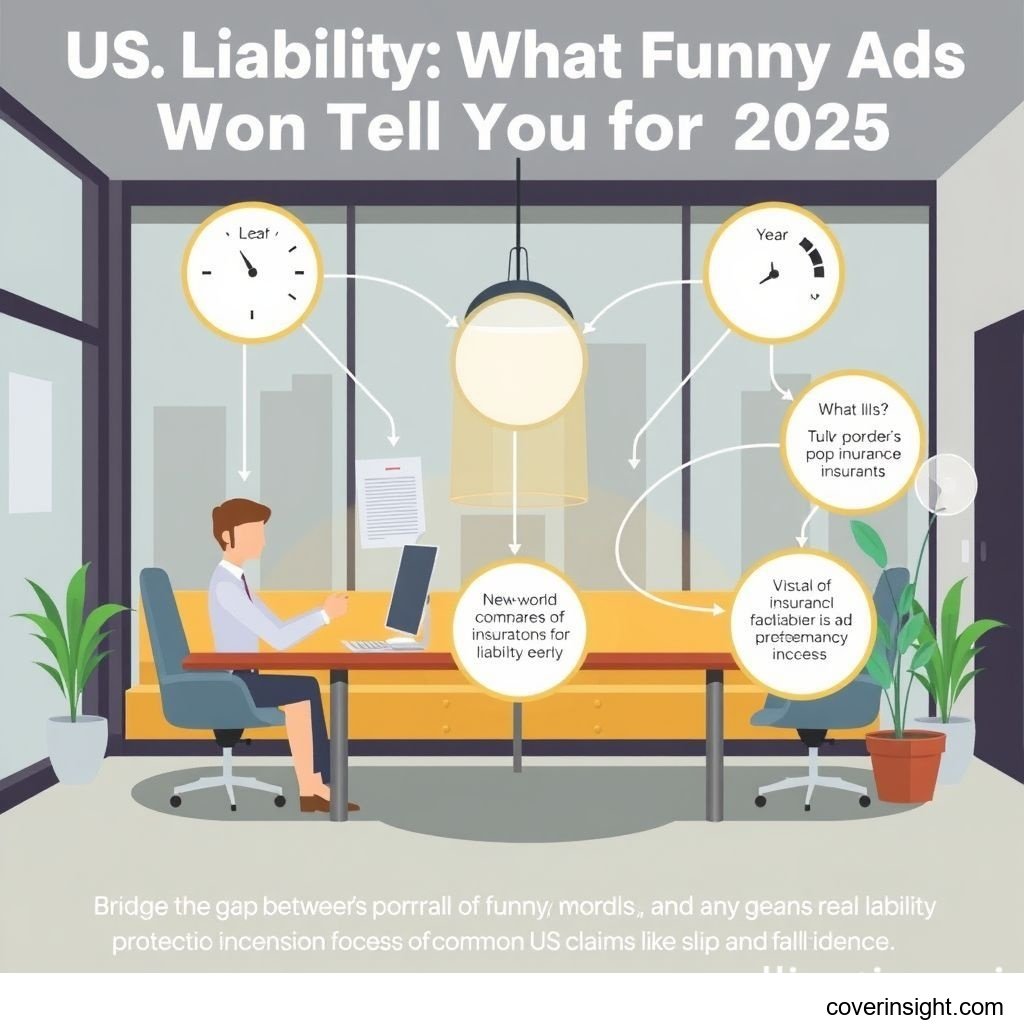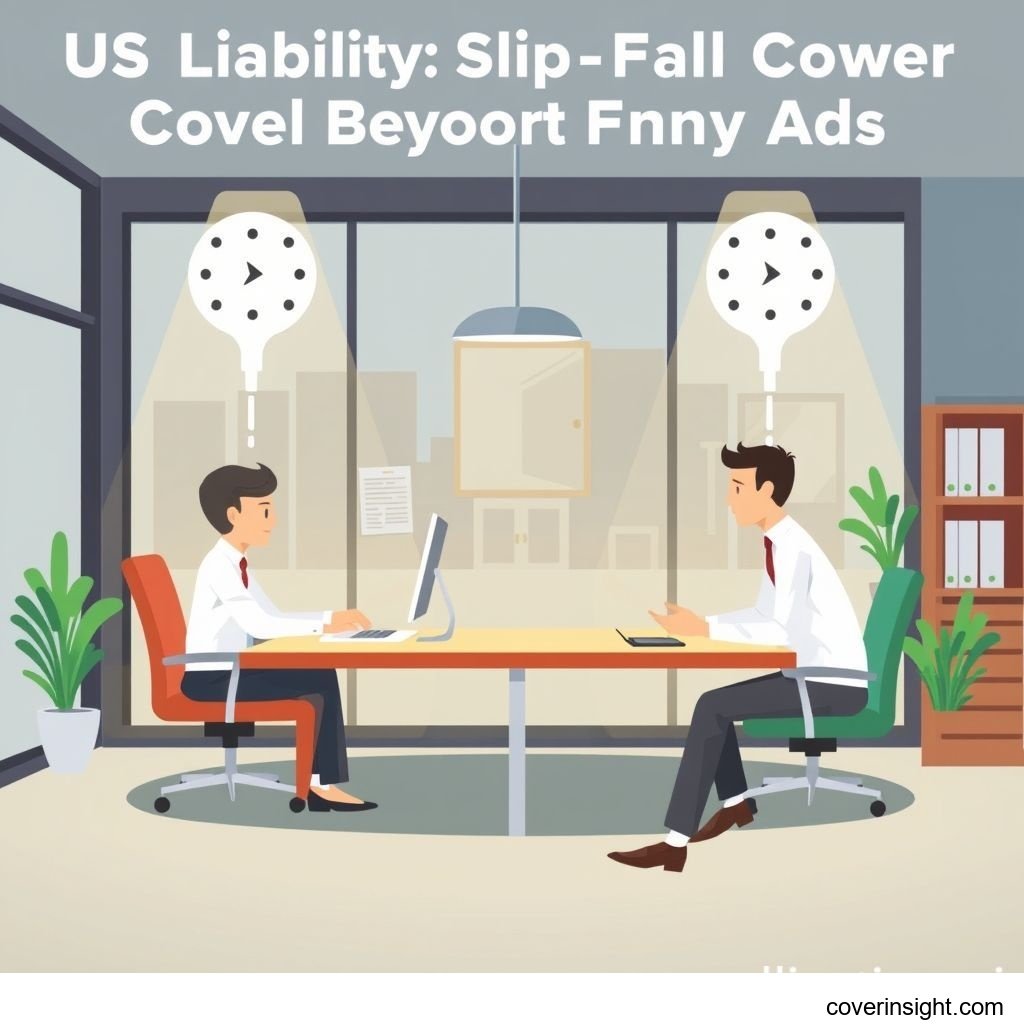US Liability: What Funny Ads Won't Tell You for 2025
Introduction
The landscape of insurance in the US is often painted with broad strokes of humor, thanks to an abundance of funny insurance commercials. These catchy advertisements feature quirky mascots, relatable mishaps, and often, a clever punchline. While they successfully grab our attention and make us chuckle, they rarely delve into the intricate realities of liability coverage. For 2025, understanding your liability is more crucial than ever, particularly when the unexpected occurs. This article aims to pull back the curtain, moving beyond the witty one-liners to provide a comprehensive look at US liability insurance and the serious protections it offers. It's time to understand what those funny insurance commercials leave out.
Coverage Details: Beyond the Giggles of Funny Insurance Commercials
While funny insurance commercials make light of everyday mishaps, real-world incidents demand serious protection. Understanding the specifics of your liability coverage is paramount. It dictates what financial burdens you might face should you be held responsible for an injury or property damage.
What’s Included
Liability insurance typically covers legal costs and damages that you are legally obligated to pay due to certain events. These events generally involve bodily injury or property damage to third parties for which you are deemed responsible.
Key components often covered include:
-
Bodily Injury Liability: This pays for medical expenses, lost wages, and pain and suffering of others if you cause an accident or incident where someone is hurt. For example, if a guest slips and falls in your home, this coverage would respond.
-
Property Damage Liability: This covers the cost to repair or replace property belonging to someone else if you are at fault for its damage. Think about backing into your neighbor's fence or a tree falling from your property onto their shed.
-
Legal Defense Costs: A significant benefit, this coverage pays for attorney fees and court costs, regardless of whether you are found liable or not. This alone can save individuals and businesses immense financial strain.
-
Medical Payments (MedPay): Often included or available as an add-on, this covers minor medical expenses for guests injured on your property, regardless of fault.
-
Personal and Advertising Injury: For businesses, this protects against claims such as libel, slander, copyright infringement, or false advertising.
Common Exclusions
Even the best policies have limitations. What funny insurance commercials rarely show are the scenarios explicitly excluded from coverage. Knowing these can prevent costly surprises.
Common exclusions often include:
-
Intentional Acts: Damage or injury caused intentionally by the insured is almost always excluded. Liability coverage is designed for accidental occurrences.
-
Criminal Acts: Any liability arising from criminal activity performed by the insured is typically not covered.
-
Business Pursuits (on personal policies): If you operate a business out of your home, your standard homeowner's policy generally won't cover business-related liability. You'll need separate commercial liability insurance.
-
Professional Services: Malpractice or errors related to professional services (e.g., doctor, lawyer, accountant) require professional liability insurance (Errors and Omissions, E&O) and are not covered by general liability.
-
Specific High-Risk Activities: Some policies exclude liability arising from certain high-risk items or activities, such as trampolines, swimming pools, or specific dog breeds, unless an endorsement is added.
-
War or Nuclear Events: Catastrophic events of this nature are universally excluded from standard liability policies.
-
Vehicle-Related Incidents: Auto accidents are covered by auto liability insurance, not by homeowner's or general personal liability policies.
Beyond the Laughs: Understanding US Liability Insurance
While funny insurance commercials simplify the concept of protection, the reality of US liability insurance is multifaceted. It's not just about covering accidents; it's about safeguarding your financial future against a myriad of potential claims. Understanding what liability insurance covers is critical for both individuals and businesses.
Types of Liability Coverage
Liability insurance isn't a one-size-fits-all product. Different aspects of your life and business require specific types of coverage.
Here are the primary categories:
-
Personal Liability (Homeowners/Renters Insurance): This is the most common form for individuals. It protects you and your family members from claims resulting from injuries or damages caused to others while on your property or away from it.
-
Auto Liability: Mandatory in most states, this covers injuries or property damage you cause to others while operating your vehicle. It is a separate policy from personal liability.
-
Commercial General Liability (CGL): Essential for businesses, CGL protects against claims of bodily injury, property damage, personal injury (like libel or slander), and advertising injury occurring on business premises or arising from business operations. This is a foundational policy for any enterprise.
-
Professional Liability (Errors & Omissions - E&O): For professionals (doctors, lawyers, consultants, real estate agents), E&O covers financial losses incurred by clients due to negligence, errors, or omissions in professional services. This goes beyond the scope of what liability insurance covers in a general sense, addressing specific professional risks.
-
Directors and Officers (D&O) Liability: Protects the personal assets of corporate directors and officers against lawsuits alleging wrongful acts in their management capacity.
-
Umbrella Liability: This type of policy provides an extra layer of liability protection above the limits of your existing auto, homeowners, or general liability policies. It kicks in when the limits of your primary policies are exhausted, offering broad coverage for significant claims that could otherwise bankrupt you.
Key Policy Components
Beyond the basic types, understanding specific policy components helps clarify what liability insurance covers.
These include:
-
Policy Limits: The maximum amount your insurer will pay out for a covered claim. This is usually expressed as per-occurrence limits and aggregate limits (total paid over the policy period).
-
Deductibles: The amount you must pay out-of-pocket before your insurance coverage kicks in. While common in property coverage, liability policies often have a zero deductible for defense costs, but may have one for specific damages.
-
Coverage Territory: Specifies the geographical areas where the policy provides coverage (e.g., US, Canada, worldwide).
-
Policy Endorsements: Additions or modifications to a standard policy that can expand or restrict coverage. For instance, adding an endorsement for a home-based business might provide limited coverage for certain risks.
Navigating Landlord Liability Issues and Other Risks with Funny Insurance Commercials in Mind
While funny insurance commercials may highlight property damage, they rarely address the unique and complex world of landlord liability issues. Owning rental property comes with specific risks that extend beyond a standard homeowner's policy.
Specific Risks for Property Owners
Property owners, particularly landlords, face a distinct set of liability challenges. Managing these risks effectively is crucial to protect your investment and financial well-being.
Key landlord liability issues include:
-
Tenant Injuries: Landlords can be held responsible for injuries sustained by tenants or their guests due to unsafe conditions on the property (e.g., faulty stairs, unaddressed hazards, insufficient lighting in common areas).
-
Property Damage by Third Parties: While tenants are often responsible for damage they cause, landlords can be liable if, for example, a structural issue causes damage to a tenant's belongings.
-
Discrimination Claims: Landlords must comply with Fair Housing laws. Claims of discrimination based on race, religion, gender, disability, familial status, or national origin can lead to significant legal battles.
-
Eviction and Entry Issues: Improper eviction procedures or unlawful entry into a tenant's unit can result in lawsuits.
-
Third-Party Criminal Acts: In some cases, landlords might be held liable if a tenant or guest is harmed by a third-party criminal act (e.g., assault, robbery) due to inadequate security measures on the property.
-
Common Area Accidents: For multi-unit properties, landlords are responsible for the safety of common areas like lobbies, stairwells, and parking lots.
To address these landlord liability issues, landlords often need a specific landlord insurance policy (also known as a dwelling fire policy or rental property insurance). This policy typically includes liability coverage tailored for rental properties, offering protection against tenant injuries and related legal costs.
Business vs. Personal Liability
The distinction between business and personal liability is critical. Many people mistakenly believe their personal homeowner's policy offers adequate coverage for a home-based business or rental property. This is a common oversight that funny insurance commercials do not clarify.
-
Personal Liability (e.g., homeowner's insurance) protects you against claims arising from incidents in your personal life. If your dog bites a neighbor, or a friend slips on your porch, your personal liability coverage kicks in.
-
Business Liability (e.g., Commercial General Liability, Professional Liability) is designed for risks associated with operating a business. If a client is injured at your home office, or a product you sell causes harm, your personal policy likely won't cover it. Similarly, as discussed with landlord liability issues, owning rental property for income is considered a business venture and requires specific landlord insurance.
Ignoring this distinction can leave you severely underinsured and financially vulnerable. It's essential to consult with an insurance professional to ensure all facets of your life, including any business or rental properties, are properly covered. For more detailed information on diverse insurance needs, visit Insurance Resources Global.
Cost Analysis: The Price Tag Behind Funny Insurance Commercials
Funny insurance commercials highlight the ease of getting a quote, but they rarely discuss the factors that genuinely influence the cost of your liability coverage. Understanding these elements can empower you to make informed decisions and potentially save money.
Price Factors
The premium for liability insurance isn't arbitrary. Several variables contribute to the final cost, reflecting the level of risk the insurer is taking on.
Key factors include:
-
Coverage Limits: Higher liability limits mean greater protection, but also a higher premium. Opting for an umbrella policy will also increase costs but offer significant peace of mind.
-
Deductible: For some liability coverages, a higher deductible (the amount you pay before insurance kicks in) can lower your premium.
-
Location: Geographic location plays a role, particularly for property and auto liability. Areas with higher crime rates, more litigation, or higher property values may have higher premiums.
-
Claim History: A history of previous liability claims can significantly increase your premiums, as it signals a higher risk to insurers.
-
Type of Property/Business: For homeowners, factors like a swimming pool, trampoline, or aggressive dog breed can increase liability risk and premiums. For businesses, the industry type, size, and specific operations heavily influence costs. For example, a construction company will pay more than a consulting firm.
-
Risk Management Practices: For businesses, implementing safety protocols, regular maintenance, and robust employee training can sometimes lead to lower premiums.
-
Credit Score (in some states): In many states, an insurance score (derived from your credit history) can influence your premium, as it's correlated with claim frequency. For more details on state-specific regulations, you can check the State Insurance Departments via the NAIC website.
Saving Tips
Finding affordable liability insurance doesn't have to be a joke, even if funny insurance commercials make it seem too easy. Here are practical ways to potentially lower your premiums without compromising essential coverage.
Consider these saving strategies:
-
Bundle Policies: Many insurers offer discounts when you purchase multiple policies (e.g., auto and home, or landlord and auto) from the same company.
-
Increase Deductibles: If applicable, choosing a higher deductible can lower your annual premium. Just ensure you can comfortably afford the deductible amount in case of a claim.
-
Improve Security/Safety: For homeowners, installing alarm systems, smoke detectors, and maintaining your property can qualify you for discounts. For businesses, robust safety programs are key.
-
Maintain a Good Credit Score: Where permitted by law, a strong credit history can result in better insurance rates.
-
Shop Around: Don't settle for the first quote. Get quotes from multiple insurers. Online comparison tools or an independent insurance agent can help you find the best rates.
-
Review Your Coverage Annually: Life changes. Ensure your coverage still meets your needs and that you're not paying for coverage you no longer require or missing essential new protections.
-
Ask About Discounts: Always inquire about any available discounts, such as for being a long-time customer, having no claims, or being part of certain professional organizations.
-
Consider an Umbrella Policy Wisely: While it adds cost, an umbrella policy can be very cost-effective for the significant amount of additional liability protection it provides, especially for high-net-worth individuals or those with significant assets.
FAQs: What Funny Insurance Commercials Don't Answer
Funny insurance commercials excel at entertainment, but they leave many crucial questions unanswered. Here are common questions people have about liability insurance, providing clarity beyond the marketing hype.
-
How much does funny insurance commercials cost?
The cost of liability insurance varies widely based on numerous factors, including the type of coverage (home, auto, business, umbrella), the limits you choose, your location, claims history, and specific risks. A basic personal liability policy through homeowners insurance might be a few hundred dollars annually, while comprehensive commercial or umbrella policies can range from thousands to tens of thousands. The best way to determine your cost is to get a personalized quote.
-
What affects premiums?
Premiums are affected by your chosen coverage limits, deductibles, location, past claims history, the type of property or business being insured, risk management efforts, and in some states, your credit score. Specific features like pools, trampolines, or certain dog breeds can also increase homeowner liability premiums.
-
Is it mandatory?
Auto liability insurance is legally mandatory in most U.S. states to register and operate a vehicle. While personal (homeowner's/renter's) liability insurance isn't legally mandated by state law, it's often required by mortgage lenders or landlords. For businesses, while not always legally mandatory, it's considered essential for financial protection and is often required by contracts or clients.
-
How to choose?
Choosing the right liability insurance involves assessing your personal assets, potential risks, and lifestyle. Consider how much you could lose in a lawsuit. Work with a reputable agent or broker who can help you understand your exposures and recommend appropriate coverage limits and types (e.g., personal, auto, umbrella, business, or specific landlord liability issues coverage). Don't just focus on the price; balance cost with adequate protection. For general guidance on insurance, consult US Insurance Home.
-
Consequences of no coverage?
Operating without adequate liability coverage can have severe financial consequences. If you are found responsible for causing injury or property damage and lack sufficient insurance, you could be personally liable for all legal costs, medical bills, and damages. This could lead to wage garnishment, asset seizure (including your home and savings), and significant long-term debt, effectively bankrupting you.
Conclusion
While funny insurance commercials certainly make us laugh, they gloss over the serious financial implications of inadequate liability coverage. For 2025, understanding what liability insurance covers, the nuances of landlord liability issues, and the factors influencing costs is crucial. Liability insurance isn't just a legal necessity for driving; it's a fundamental safeguard for your assets and future. By looking beyond the humor and focusing on comprehensive protection, you can ensure that when life's unexpected challenges arise, you're not left wishing for a punchline, but rather, resting assured in your sound financial planning.








Comments